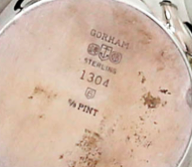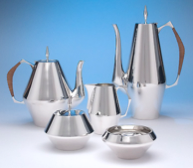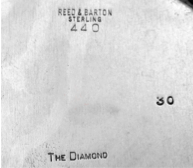
C H I P S T O N E
Sterling silver is an alloy of silver containing 92.5% by mass
of silver and 7.5% by mass of other metals, usually copper.
The sterling silver standard has a minimum millesimal
fineness of 925.
of silver and 7.5% by mass of other metals, usually copper.
The sterling silver standard has a minimum millesimal
fineness of 925.
Fine silver, for example 99.9% pure silver, is generally too
soft for producing functional objects; therefore, the silver is
usually alloyed with copper to give it strength while
preserving the ductility and beauty of the precious metal.
Other metals can replace the copper, usually with the
intention of improving various properties of the basic
sterling alloy such as reducing casting porosity, eliminating
firescale, and increasing resistance to tarnish.[citation
needed] These replacement metals include germanium,
zinc and platinum, as well as a variety of other additives,
including silicon and boron. Alloys such as Argentium
sterling silver have appeared in recent decades.One of the
earliest attestations of the term is in Old French form
esterlin, in a charter of the abbey of Les Préaux, dating to
either 1085 or 1104. The English chronicler Orderic Vitalis
(1075 – c. 1142) uses the Latin forms libræ sterilensium and
libræ sterilensis monetæ. The word in origin refers to the
newly introduced Norman silver penny.
soft for producing functional objects; therefore, the silver is
usually alloyed with copper to give it strength while
preserving the ductility and beauty of the precious metal.
Other metals can replace the copper, usually with the
intention of improving various properties of the basic
sterling alloy such as reducing casting porosity, eliminating
firescale, and increasing resistance to tarnish.[citation
needed] These replacement metals include germanium,
zinc and platinum, as well as a variety of other additives,
including silicon and boron. Alloys such as Argentium
sterling silver have appeared in recent decades.One of the
earliest attestations of the term is in Old French form
esterlin, in a charter of the abbey of Les Préaux, dating to
either 1085 or 1104. The English chronicler Orderic Vitalis
(1075 – c. 1142) uses the Latin forms libræ sterilensium and
libræ sterilensis monetæ. The word in origin refers to the
newly introduced Norman silver penny.
Title of Post
00-00-2014 (date of post)
Name of Person Posting
Research Archive
| Directional, 1956. Gorham sterling tea and coffee service, sterling with ebony. |


| Diamond, 1958. Reed & Barton sterling tea and coffee service. Sterling with plastic. Designer John Prip. |


According to the Oxford English Dictionary, the most
plausible etymology is derivation from a late Old English
steorling (with (or like) a "little star"), as some early
Norman pennies were imprinted with a small star. There
are a number of obsolete hypotheses. One suggests a
connection with starling, because four birds (in fact
martlets) were depicted on a penny of Edward I, and
another, a supposed connection with easterling, a term for
natives of the Baltic, or the Hanse, towns of eastern
Germany. This etymology is itself medieval, suggested by
Walter de Pinchebek (ca. 1300) with the explanation that
the coin was originally made by moneyers from that
region. [1]
plausible etymology is derivation from a late Old English
steorling (with (or like) a "little star"), as some early
Norman pennies were imprinted with a small star. There
are a number of obsolete hypotheses. One suggests a
connection with starling, because four birds (in fact
martlets) were depicted on a penny of Edward I, and
another, a supposed connection with easterling, a term for
natives of the Baltic, or the Hanse, towns of eastern
Germany. This etymology is itself medieval, suggested by
Walter de Pinchebek (ca. 1300) with the explanation that
the coin was originally made by moneyers from that
region. [1]
1. "sterling, n.1 and adj.". OED Online. December 2011. Oxford
University Press. Entry 189985 (accessed February 28, 2012).
University Press. Entry 189985 (accessed February 28, 2012).
Relative Links
Poster to find and put here